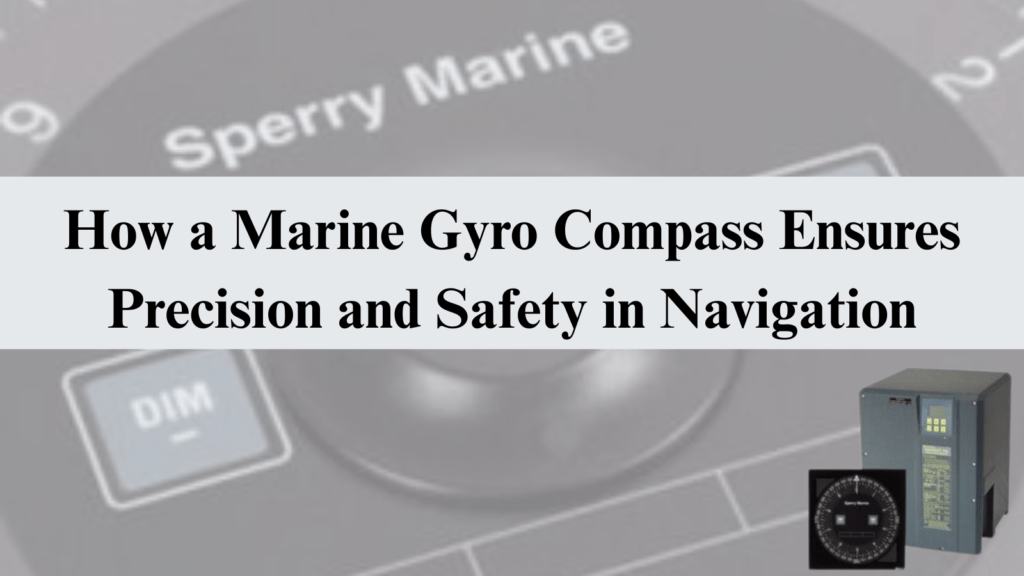In the vast expanse of open water, precision and reliability in navigation are non-negotiable. For centuries, mariners relied on magnetic compasses to steer their vessels. While effective, magnetic compasses are susceptible to interference from surrounding metallic structures, electromagnetic fields, and variations in Earth’s magnetic field. Enter the marine gyro compass—a technological advancement that has revolutionized maritime navigation by providing accurate directional guidance regardless of magnetic disturbances. In this blog, we explore how the marine gyro compass works and why it plays a crucial role in ensuring precision and safety at sea.
What is a Marine Gyro Compass?
A marine gyro compass is a navigational instrument that uses the principles of angular momentum and Earth’s rotation to determine true north, rather than magnetic north. Unlike magnetic compasses, which align with the Earth’s magnetic field, the gyro compass seeks out the geographic North Pole, offering a more stable and accurate reading over time and distance.
Developed in the early 20th century, gyro compasses have become standard equipment aboard commercial vessels, naval ships, and submarines due to their ability to maintain accuracy even in rough seas or near large metal structures.
The Science Behind the Gyro Compass
At the core of the gyro compass is the gyroscope—a spinning wheel or rotor mounted on an axis. A gyroscope maintains its orientation regardless of the movement of its base. This property, known as gyroscopic inertia, is key to its functionality.
The gyro compass takes this principle further by using the Earth’s rotation to detect and align with true north. When the spinning gyroscope is mounted in a set of gimbals and subjected to forces that allow it to respond to Earth’s rotation, it naturally settles into alignment with the Earth’s rotational axis. Damping mechanisms and control systems further correct any drift, stabilizing the reading and keeping the compass aligned with geographic north.
Key Advantages of a Marine Gyro Compass
- True North Alignment: One of the most significant advantages of the gyro compass is its ability to point to the true north, not magnetic north. This eliminates the need to correct for magnetic declination—a factor that varies based on geographic location and can complicate navigation with magnetic compasses.
- Resistance to Magnetic Interference: Because the gyro compass doesn’t rely on the Earth’s magnetic field, it remains unaffected by magnetic anomalies or the presence of ferrous metals and electrical systems aboard the ship. This is particularly critical in naval vessels, submarines, or modern ships with complex electronic systems.
- Stable Readings in All Conditions: Gyro compasses provide stable and reliable readings even in turbulent seas. Their design compensates for pitch, roll, and yaw, maintaining directional accuracy regardless of how the vessel is moving. This stability is crucial for long-distance voyages, high-speed vessels, and operations requiring pinpoint accuracy.
- Integration with Navigation Systems: Modern gyro compasses are designed to integrate seamlessly with autopilot systems, radar, electronic chart systems (ECDIS), and other navigation instruments. This connectivity allows for real-time data sharing, improved situational awareness, and enhanced automation in course correction.
- Continuous Operation: The directional information delivered by gyro compasses remains constant and is not affected by degradation issues that can impact magnetic compasses over time. The devices operate continuously throughout the day once powered and calibrated, requiring minimal upkeep.
Enhancing Maritime Safety
- Precision Navigation: Mission-critical navigation for ships operating near shipping lanes or port areas can be extremely hazardous due to the risks associated with even minimal positional errors. Ships equipped with gyro compasses enable captains and navigators to execute precise maneuvers, especially during complex operations.
- Support for Advanced Maneuvering: Modern ships make use of advanced steering systems and dynamic positioning technologies. These systems require accurate heading information to adjust thrust and control mechanisms in real-time. Such operations in offshore oil platforms, research vessels and cruise ships require a gyro compass to deliver reliable navigation inputs.
- Compliance and Regulation: Vessels under the supervision of the International Maritime Organization (IMO) are required to use gyro compasses mandatorily. This compliance serves dual purposes to protect maritime safety operations and fulfill navigation regulations in international waters.
- Redundancy in Navigation: Additional safety is achieved through vessel operations that use multiple navigation systems. The critical satellite navigation system which operates as GPS remains essential yet becomes vulnerable to jamming and spoofing threats. Operating with a gyro compass as an independent navigation system provides ship operators with two capabilities that boost maritime operational stability.
Real-World Applications
- Cargo Ships: Gyro compasses serve as essential devices for stable heading data in large cargo ships because they guarantee precise navigation during lengthy transoceanic routes.
- Naval Vessels: Exactly positioned navigation and magnetic stealth operations remain essential for all naval vessels as well as submarines. Gyro compasses operate without noise as well as without interference.
- Cruise Liners: Cruise Liners depend on gyro compass systems to guarantee passenger security as well as keeping accurate navigation routes. A combination of integrated gyro compasses allows vessels to achieve safe navigation through complicated routing paths.
- Research Vessels: Undersea scientists operating research vessels require gyro compass systems to ensure reliable, precise navigation for ROV deployments and scientific studies.
Evolution and Modern Innovations
Traditional mechanical gyro compasses are still in use, but advancements in technology have led to the development of two modern systems: Fiber-Optic Gyroscopes (FOG) and Ring Laser Gyroscopes (RLG). The latest gyroscopic systems have no moving components and provide superior performance within compact spaces with reduced requirements for maintenance.
Dedicated real-time monitoring software together with digital interfaces makes ship operator tasks of gyroscope calibration, data inspection and system troubleshooting significantly more convenient.
Precision Navigation Powered by Gyro Technology
In an age where maritime navigation relies heavily on precision, automation, and safety, the marine gyro compass remains a cornerstone technology. Its ability to provide true north alignment, resist interference, and deliver stable data in all conditions makes it indispensable for both traditional and modern vessels. Whether navigating through stormy seas or docking in a busy harbor, the gyro compass plays a silent but vital role in keeping ships on course and ensuring the safety of crew, cargo, and passengers alike.
As maritime technology continues to evolve, the gyro compass stands as a testament to the enduring value of engineering principles applied to the challenges of the sea—offering a perfect blend of reliability, accuracy, and innovation.














